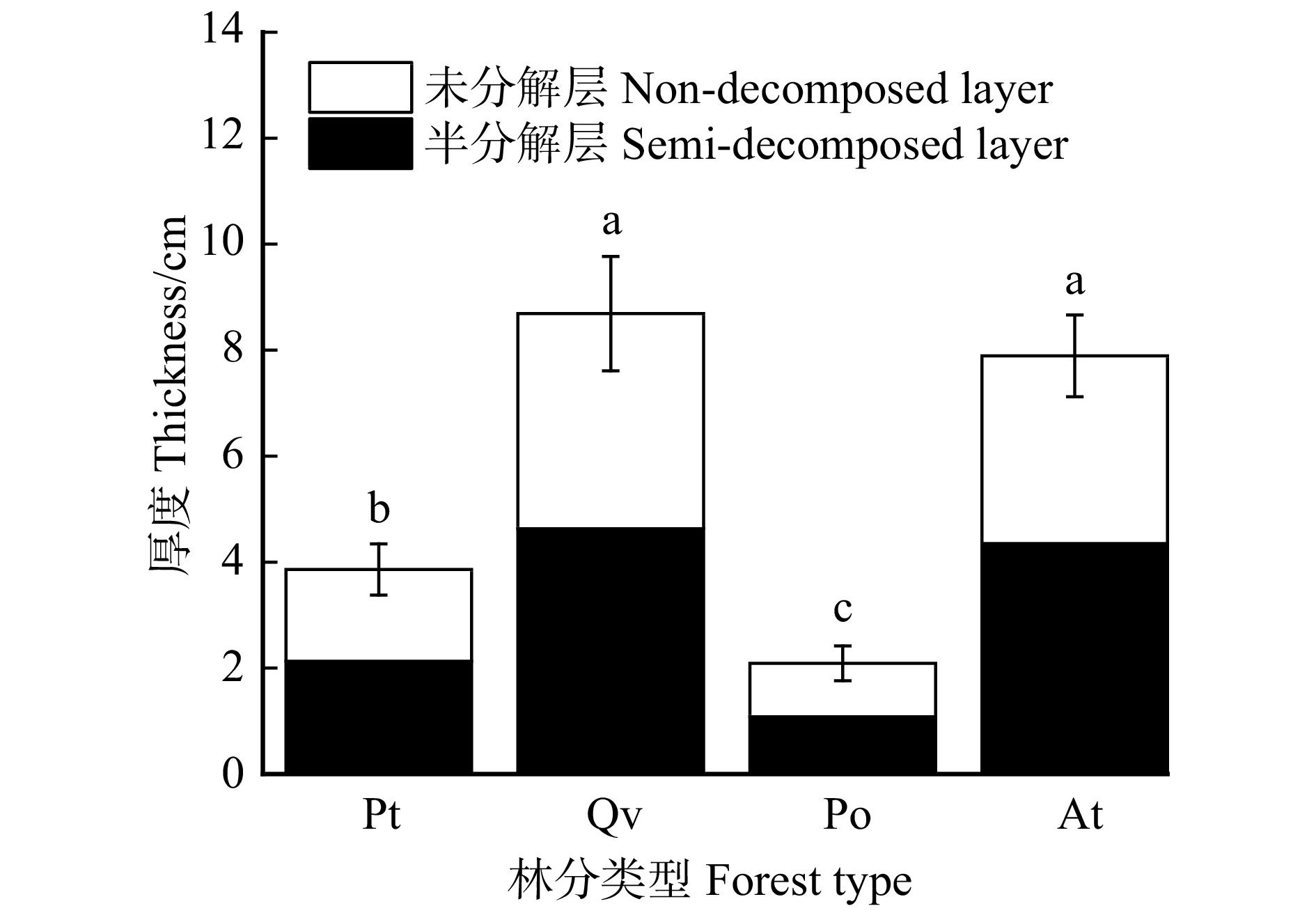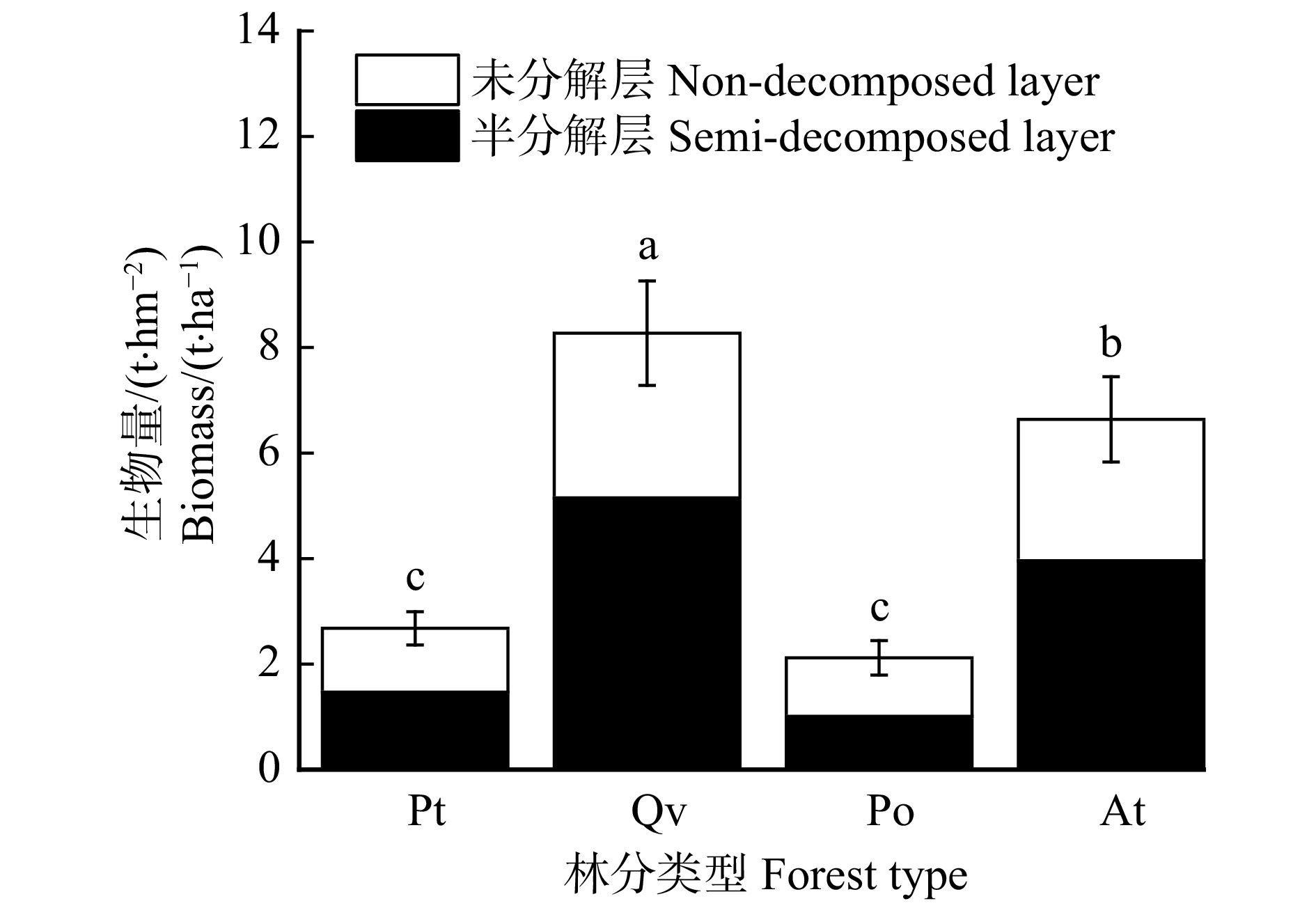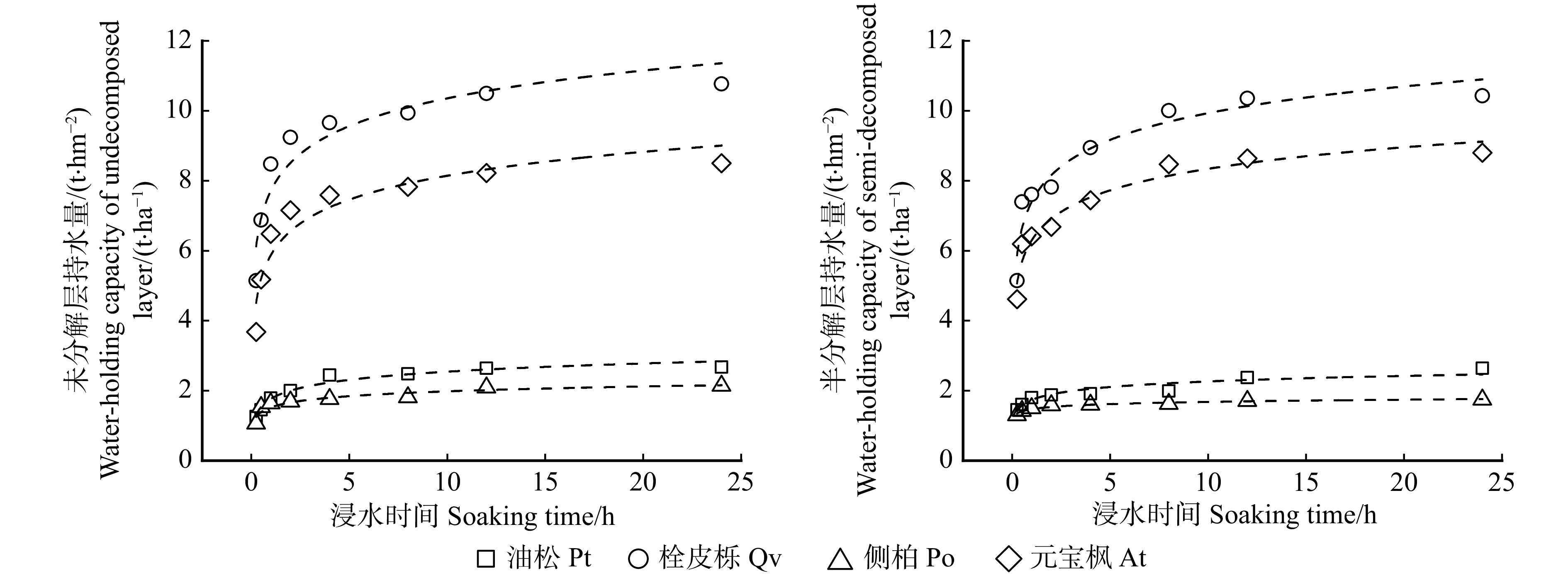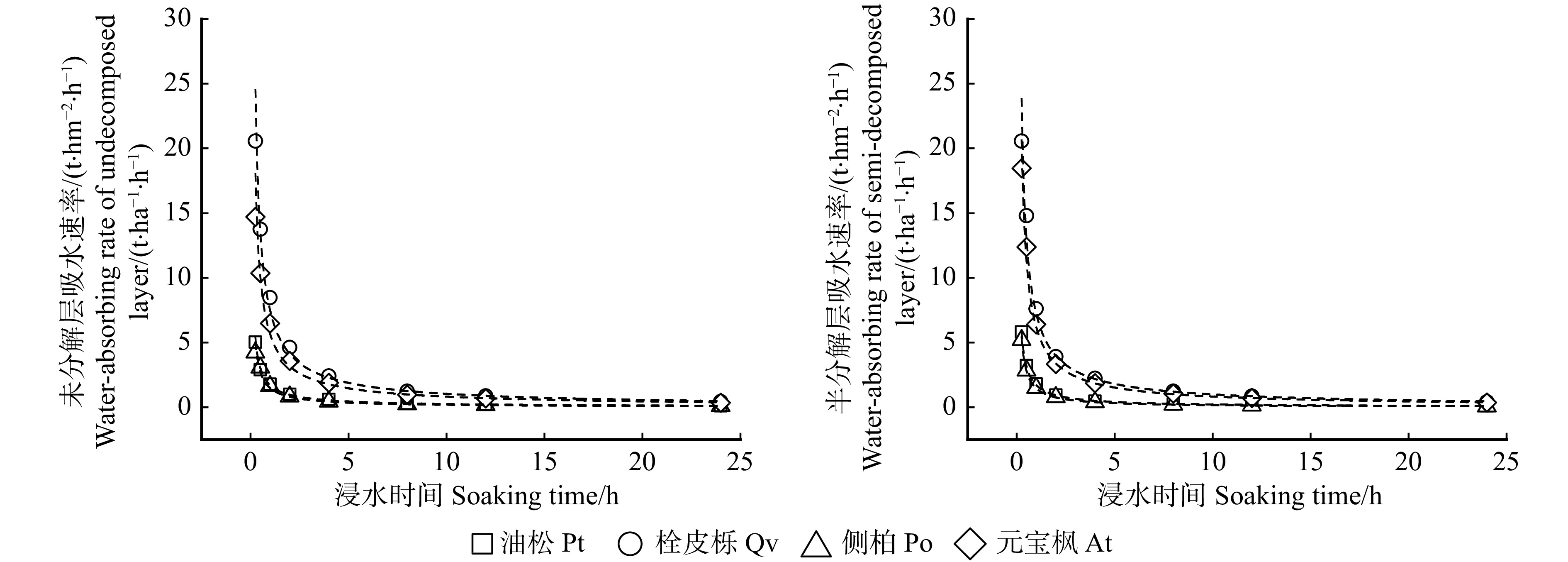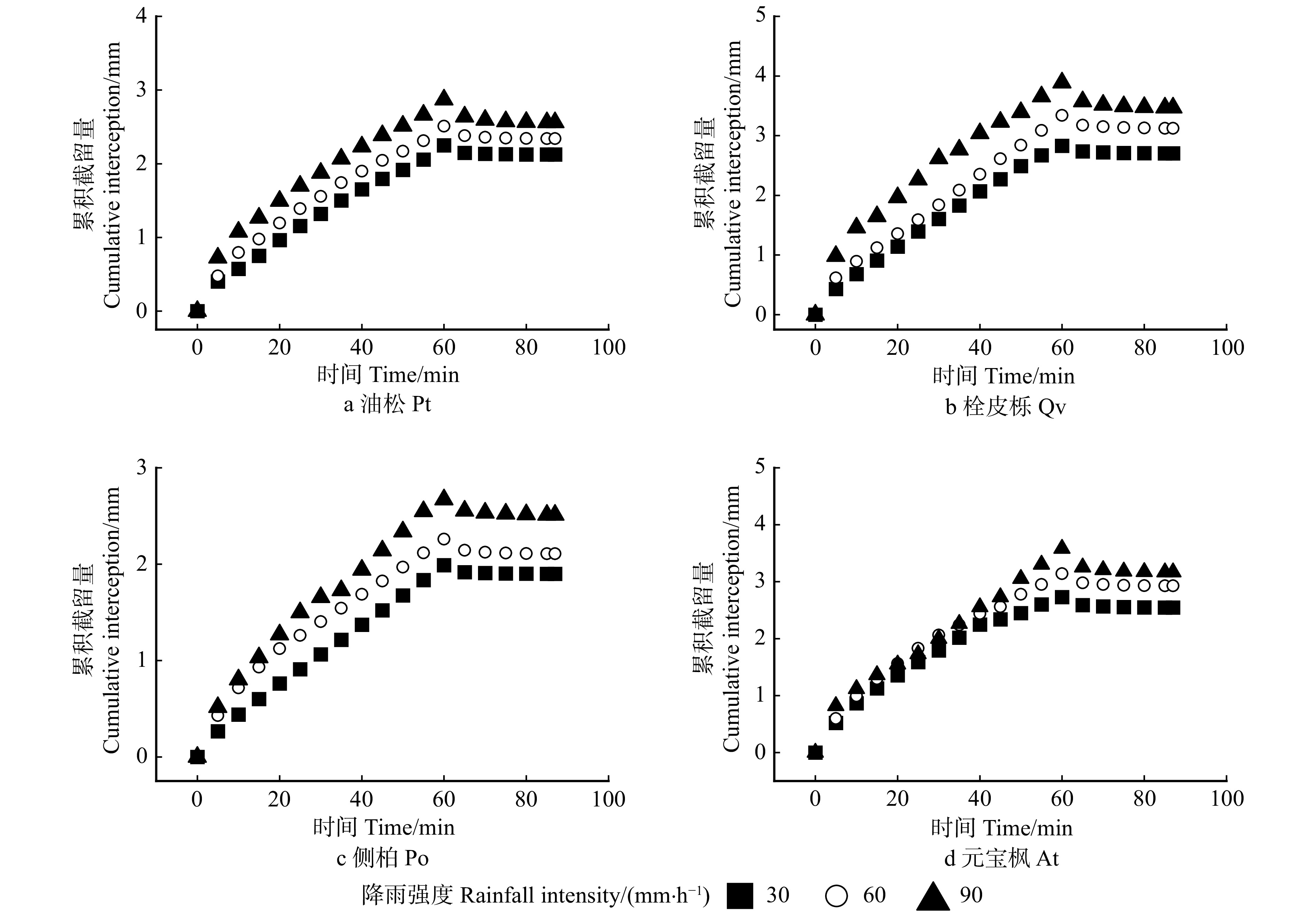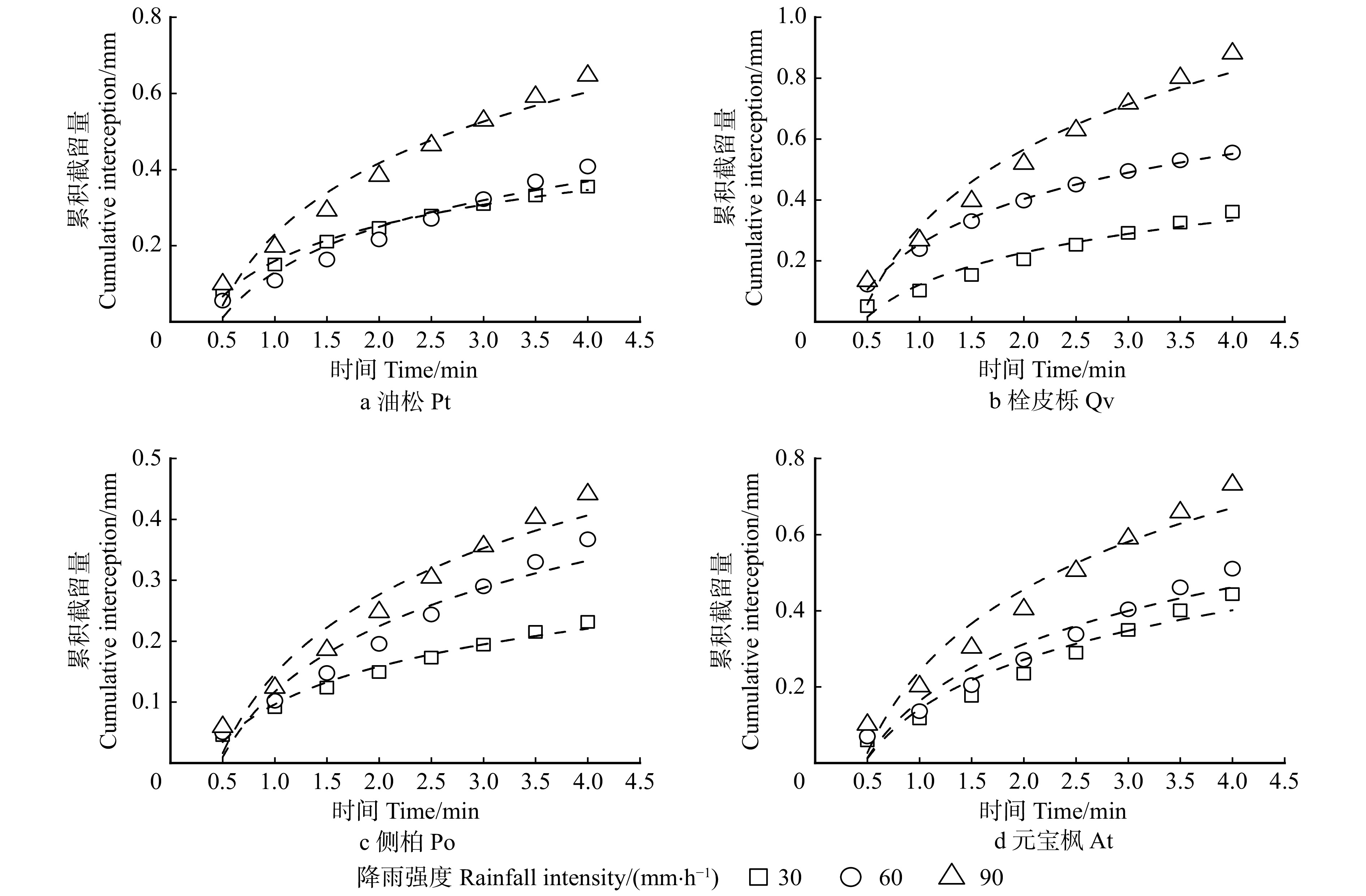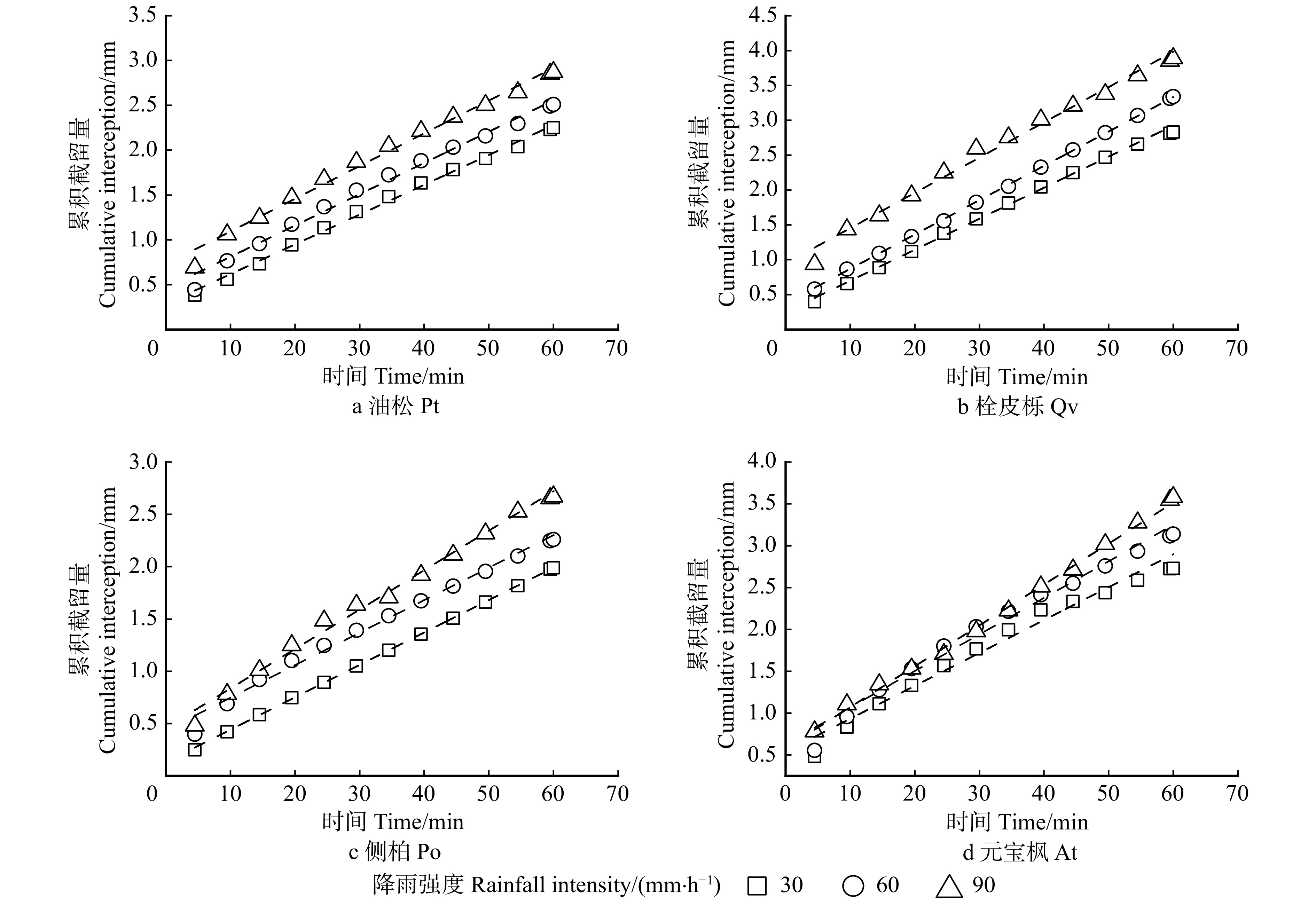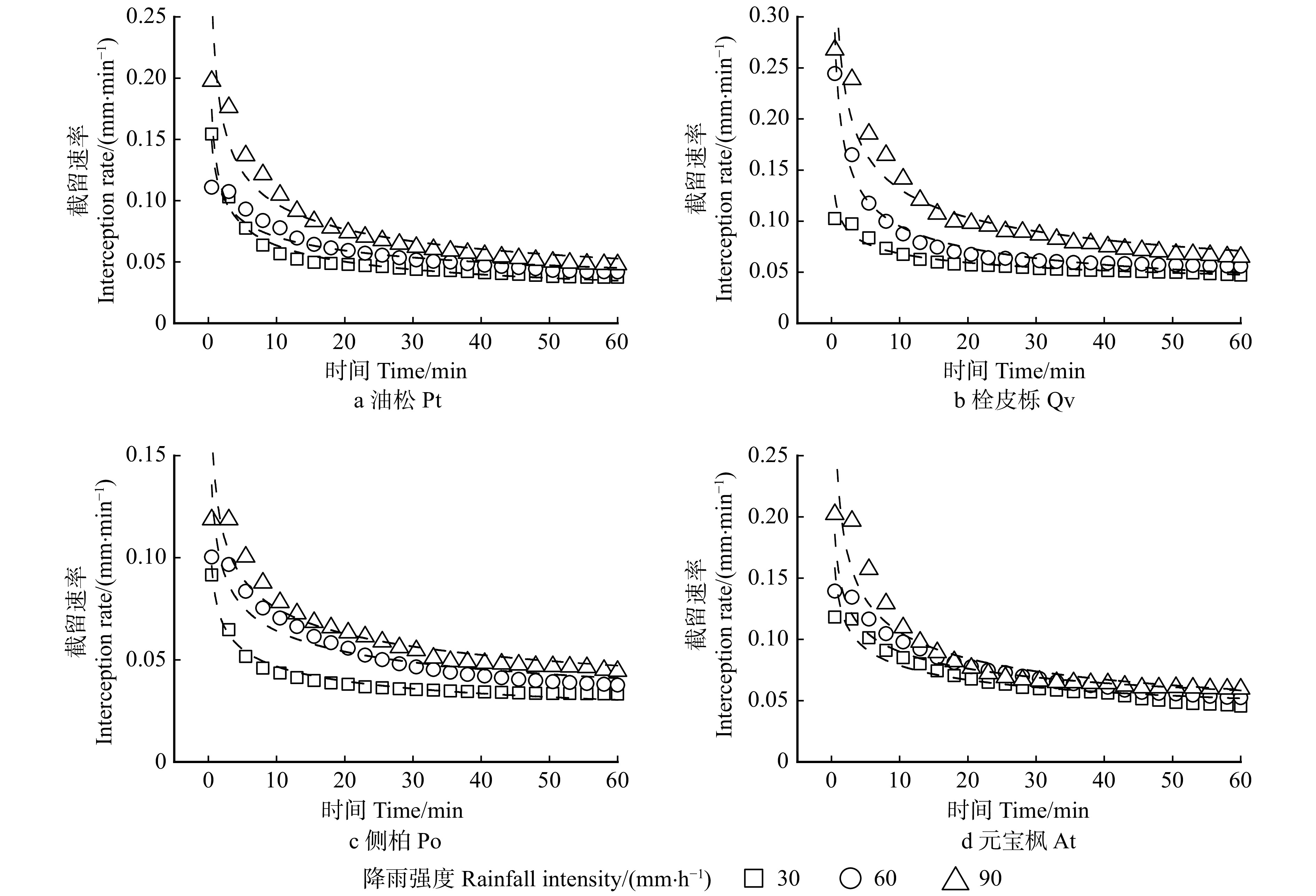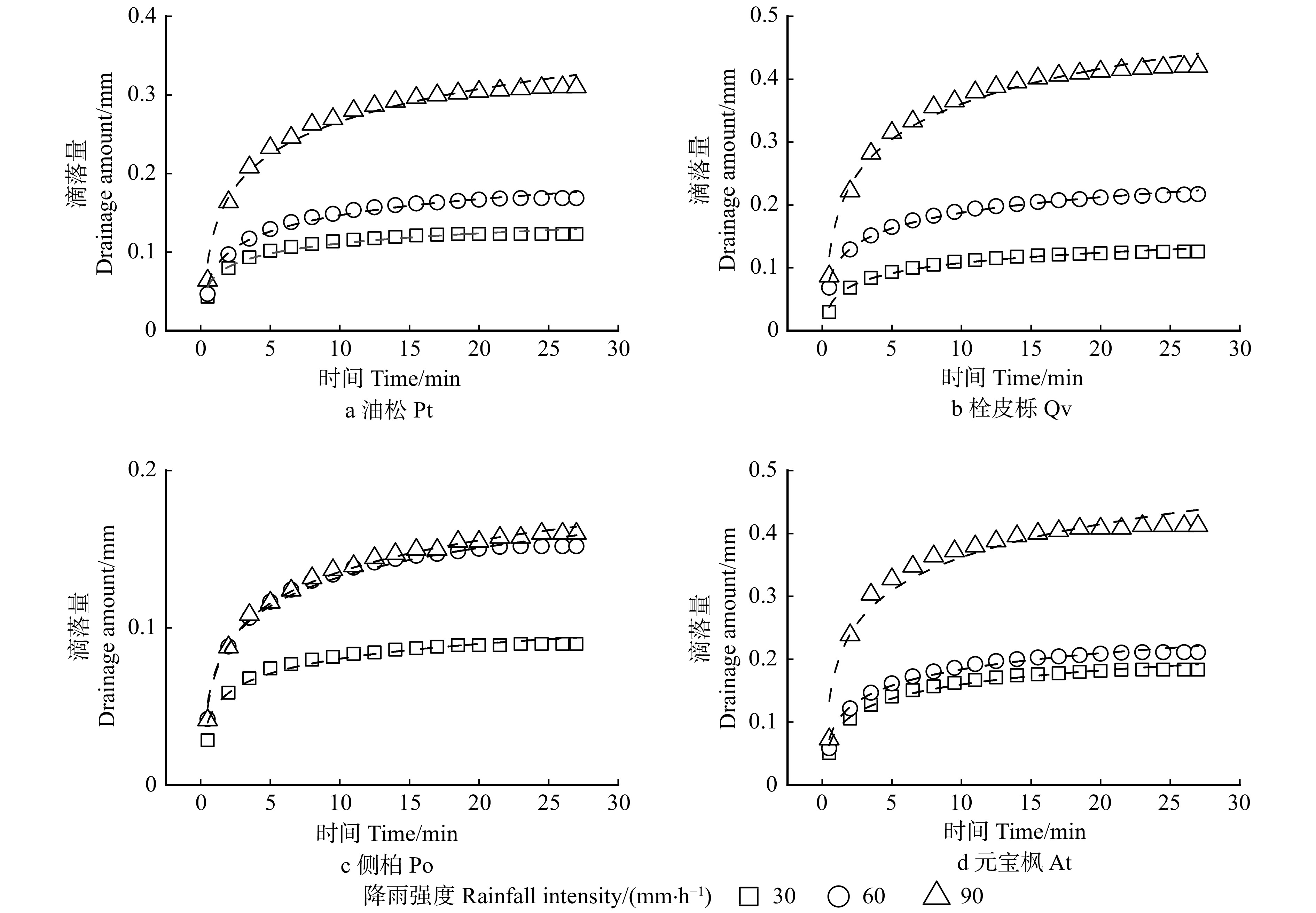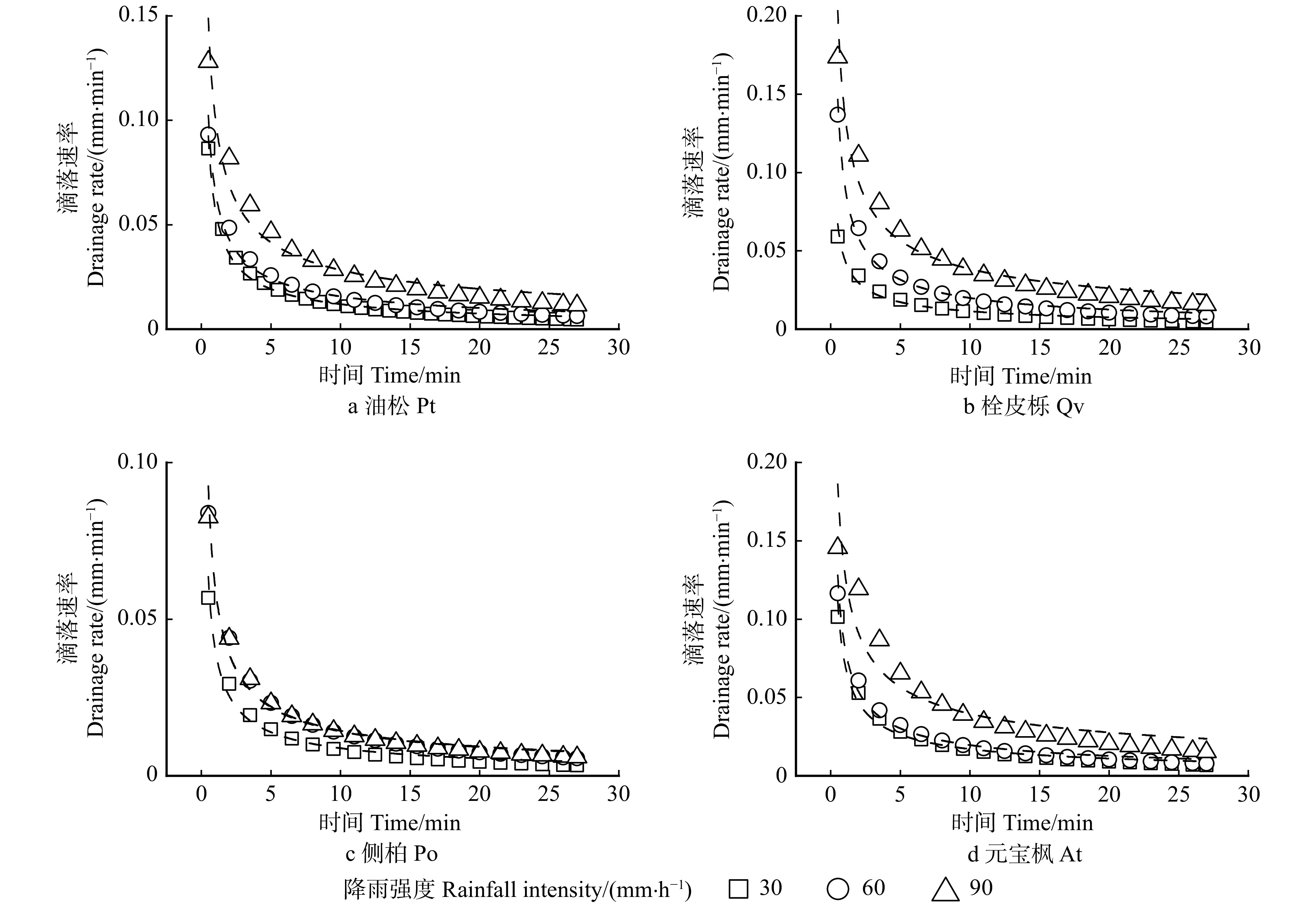Eco-hydrological effects of litter layer in typical artificial forest stands in Xishan Mountain of Beijing
-
摘要:目的 为定量评价北京西山森林枯落物层的生态水文效应,从枯落物储量、厚度、持水能力、截留能力等方面量化枯落物层的生态水文过程。方法 于2020—2021年,选择海拔、坡度、坡向、坡位、林龄、密度等均大致接近的4种典型人工林分(油松、栓皮栎、侧柏、元宝枫)为研究对象。通过野外样地实测以及室内浸泡试验、室内人工模拟降雨试验分析各类型枯落物层的结构及生态水文特征,实现典型人工林分枯落物层生态水文效应的量化表达。结果 (1)枯落物层储量范围为2.12 ~ 8.27 t/hm2,厚度范围为2.09 ~ 8.69 cm,均表现为栓皮栎枯落物最大,侧柏枯落物最小。(2)各类型枯落物不分层总最大持水量为栓皮栎(21.20 t/hm2),元宝枫(17.30 t/hm2),油松(5.32 t/hm2),侧柏(3.88 t/hm2)。针阔叶枯落物最大持水能力不同且差异显著(P < 0.05)。(3)针叶枯落物最大截留量均值为2.43 mm,阔叶枯落物最大截留量均值为3.25 mm;针叶枯落物最小截留量均值为2.26 mm,阔叶枯落物最小截留量均值为2.99 mm。各类型枯落物层最大截留量和最小截留量均随降雨强度增加而增加,但针阔叶枯落物之间截留能力存在显著差异(P < 0.05)。(4)随着降雨强度的逐步增大,各类型枯落物1 h持水量在相应的最大截留量和最小截留量中所占的比例均逐步减小。结论 北京西山4种典型人工林分中,栓皮栎林下枯落物层截留能力最大,侧柏最小,阔叶林整体要大于针叶林。因此建议研究区合理优化树种组成和林分结构配置,兼顾防治土壤侵蚀和林分湿润,减少无效蒸腾,从而实现生态水文功能的整体提高。Abstract:Objective In order to quantitatively evaluate the eco-hydrological effects of forest litter layer in Xishan Mountain of Beijing, the study quantified the eco-hydrological process of litter layer from the aspects of litter storage, thickness, water holding capacity and interception capacity.Method From 2020−2021, four typical artificial forest stands (Pinus tabuliformis, Quersus variabilis, Platycladus orientalis and Acer truncatum) with approximately similar altitude, slope, aspect, position, stand age and density were selected for the study. The structure and eco-hydrological characteristics of each type of litter layer were analyzed by field measurement, indoor immersion experiment and indoor artificial simulated rainfall experiment, so as to realize the quantitative expression of eco-hydrological effects of typical artificial forest stand litter layer.Result (1) The storage range of litter layer was 2.12−8.27 t/ha, and the thickness range was 2.09−8.69 cm, all showed that the litter of Quercus variabilis was the largest and that of Platycladus orientalis was the smallest. (2) The total maximum water holding capacity of all types of litter without stratification was 21.20 t/ha for Quersus variabilis, 17.30 t/ha for Acer truncatum, 5.32 t/ha for Pinus tabuliformis and 3.88 t/ha for Platycladus orientalis. The maximum water holding capacity of coniferous and broadleaved litter was different and significantly different (P < 0.05). (3) The mean value of maximum interception capacity of coniferous litter was 2.43 mm, and that of broadleaf litter was 3.25 mm. The mean value of minimum interception capacity of coniferous litter was 2.26 mm, and that of broadleaf litter was 2.99 mm. Both maximum interception capacity and minimum interception capacity of each type of litter layer increased with the increase of rain intensity, however, there was a significant difference in interception capacity between coniferous and broadleaf litter (P < 0.05). (4) With the gradual increase of rain intensity, the proportion of 1 h water holding capacity in the corresponding maximum interception capacity and minimum interception capacity of all types of litter decreased gradually.Conclusion Among the four typical artificial forest stands in Xishan Mountain of Beijing, the interception capacity of litter layer of Quersus variabilis forest was maximum, while that of Platycladus orientalis was minimum, and broadleaved forests as a whole are larger than coniferous forests. Therefore, it is suggested that the study area should reasonably optimize the composition of tree species and the configuration of forest structure, give consideration to the prevention and control of soil erosion and forest moisture, and reduce ineffective transpiration, so as to achieve the overall improvement of ecological and hydrological functions. Therefore, it is suggested that the study area should reasonably optimize the composition of tree species and the configuration of forest structure, give consideration to the prevention and control of soil erosion and forest moisture, and reduce ineffective transpiration, so as to achieve the overall improvement of ecological and hydrological functions.ecological and hydrological functions.Therefore, it is suggested that the tree species composition and stand structure configuration of the study area be reasonably optimized, taking into account the prevention of soil erosion and stand wetting, and reducing ineffective transpiration, so as to achieve an overall improvement of eco-hydrological function.
-
在农林业生产中,植物常遭受重金属等各种土壤条件胁迫。铅(Pb)是重金属污染物中影响较严重的元素之一,又是植物非必需元素,其在组织中大量积累会引起植物体内细胞膜脂过氧化,最终影响生长和品质[1-2],因此修复Pb胁迫土壤具有重要意义。作为生态修复的重要内容之一,植物修复已成为近年来国际环境领域研究的热点[3]。在Pb胁迫土壤的植物修复中,特别是在植物生长初期,如何提高植物适应性和存活力尤其引人关注。
作为一种天然螯合剂,土壤中各种来源的有机酸显著影响重金属在土壤中的迁移转化行为及植物有效性,在控制Pb等重金属生物毒性方面发挥重要作用[4-5]。植物对重金属的解毒机制包括外部排斥和内部耐受两类,这两类机制中有机酸均起重要作用[6-7]。外部排斥机制即有机酸与金属离子形成稳定的金属配位体复合物,阻止金属离子进入植物体内或避免其在根部敏感位点累积;内部耐受机制即有机酸可与进入植物体内的金属离子螯合,使其转化为无毒或毒性较小的结合形态[7-8]。在重金属胁迫下,植物一般通过多种机制的联合以防止中毒,但植物种类不同解毒机制也不同[7]。有机酸还显著影响Pb胁迫下植物的多种生理生化特性、生长和生物量分配格局,最终提高Pb胁迫土壤上植物的生态适应性及土壤修复效率[4]。有机酸对上述指标的影响,不仅与植物种类有关,还与有机酸种类和浓度、Pb胁迫程度和处理时间等密切相关[11]。目前,有机酸提高植物适应性的作用已在一些植物上证实,如欧洲油菜(Brassica napus)、马蔺(Iris lactea var. chinensis)等,有机酸种类涉及草酸、柠檬酸和水杨酸等,测定指标涉及电导率、可溶性蛋白含量、Pb吸收和生物量积累等[9-11]。值得指出的是,除上述常规指标外,叶绿素荧光参数、根系形态特性和养分元素吸收也是鉴定植物抗逆性的重要指标,是植物适应土壤环境的基础[12];且F0、Fv/Fm和Fv/F0等荧光指标、比根长等根系形态特征及Fe等养分元素吸收状况对Pb胁迫都非常敏感[13-14]。但目前,外源有机酸影响植物对土壤Pb胁迫的适应性研究仍集中在农业领域,在林业领域相对较少,特别是如何影响Pb胁迫下林木的叶绿素荧光参数、根系形态特性和营养元素吸收运输还鲜见报道。
我国东北林区有一定面积的矿山土急需复垦,如黑龙江省伊春西林铅锌矿等。这些立地条件下,Pb胁迫普遍存在。长白落叶松(Larix olgensis)是东北山区的重要乡土树种,因成活率高和对环境要求不甚严格,就成为Pb胁迫矿山土植被恢复和林业复垦的先锋树种。但在较严重的Pb胁迫下,其成活和生长仍受较大限制,特别是初期“造林不成活”现象普遍存在。通过前人研究可以假设,外源有机酸亦能在苗期提高长白落叶松对Pb胁迫的适应性和抗性。但目前,有机酸如何影响Pb胁迫下长白落叶松幼苗的生态适应性还未见报道。草酸和柠檬酸是我国东北林区森林凋落物淋洗液中存在的2种优势有机酸,数量均较为可观[15]。本文模拟此区长白落叶松凋落物淋洗液中草酸和柠檬酸浓度范围[15],通过外源添加不同浓度草酸或柠檬酸溶液,系统研究了不同处理时间下,有机酸对长白落叶松幼苗多种生理生化特性、Pb及养分元素吸收及生长的影响,特别是首次揭示了有机酸如何影响Pb胁迫下苗木的叶绿素荧光参数、根系形态特征及养分元素吸收状况。研究旨在探讨有机酸对Pb胁迫下苗木生态适应性的调控意义及机制,从而为有机酸应用于Pb矿区废弃地的植被恢复提供生理生态学理论依据,也能为Pb胁迫土壤的有效利用开辟新思路。
1. 材料与方法
1.1 苗木培育与处理
实验在东北林业大学帽儿山实验林场温室内进行。长白落叶松种子选种、消毒、雪藏催芽后,2016年4月末播种于塑料育苗盆(底径16.2 cm、上口径18.4 cm、高20.0 cm),覆土料为质地均一、无杂质的A1层暗棕壤(本区地带性土壤,基本性质见表 1)。土壤采自林场内长白落叶松人工林下,去除根系、土壤动物等,自然风干1 d,装盆,每盆5.5 kg。每盆育苗60株,盆上沿土壤空出2~3 cm以浇水、有机酸和Pb处理。2016年5月末间苗,每盆剩30株(由于当地气候条件限制,苗木生长缓慢,出苗1个月时平均苗高仅4.3 cm,平均地径1.05 cm,这样的密度有利于形成良好的种群优势,而不会产生生长空间的竞争)。
表 1 供试A1层暗棕壤的基本性质Table 1. Selected properties of A1 horizon of dark brown forest soil used in the experiment土壤层次
Soil layerpH值
pH value (H2O)阳离子交换量
Cation exchange capacity/(cmol·kg-1)有机质
Organic matter/ (g·kg-1)全氮
Total N/ (g·kg-1)全磷
Total P/ (g·kg-1)速效磷
Available P/ (mg·kg-1)土壤质地
Soil texture黏粒Clay (<2 μm)/ (g·kg-1) 草酸含量
Oxalic acid concentration/(μg·kg-1)柠檬酸含量
Citric acid concentration/(μg·kg-1)A1 5.32 40.2 107.9 6.39 2.08 45.8 壤质
Loamy texture135 310.98 139.83 注:30 mmol/L NH4F+25 mmol/L HCl浸提法;A1为暗棕壤层。下同。Notes: means extracted with 30 mmol/L NH4F+25 mmol/L HCl; A1 means horizon of dark brown forest soil. The same below. 缓苗1月后,将Pb(NO3)2溶液均匀地添加到土壤中以进行Pb胁迫处理,使土壤内Pb2+含量达100 mg/kg(依前期调查的黑龙江省伊春西林铅锌矿区土壤Pb含量设定)。Pb处理10 d后,采取灌根方式进行外源有机酸添加处理[草酸(OA)或柠檬酸(CA)],使土壤内有机酸浓度分别达0、0.04、0.2、1.0和2.0 mmol/kg。另外,在长白落叶松苗期,由于其根系生长慢且发育不完全[16],还采用类似叶面施肥的方式进行了有机酸喷施[17]。具体讲:将有机酸溶液(浓度分别为0、0.2、1.0、5.0和10.0 mmol/L)均匀地喷施在苗木叶片的上、下表面,以叶面均匀湿润为止。实验处理见表 2。有机酸以有机盐形式添加(pH 5.16,仿当地土壤溶液平均pH值),每天1次,共7 d,均在早晨08:00进行。土壤无Pb胁迫、等量蒸馏水处理为对照(CK)。由于当地气候寒冷,温室育苗最早也得在4月末进行,8月下旬叶片已开始变黄脱落,不能再进行相关指标的准确测定。综合考虑出苗、缓苗、Pb胁迫和有机酸处理等时间,分别在有机酸处理后第10、20、30天采样分析。每处理栽10盆苗,每个处理时间10个重复,3个时间共300盆。
表 2 实验设计(10、20、30 d均进行如下处理)Table 2. Experimental layout (each of the treatments below was sampled after 10, 20, or 30 days)处理Treatment 土壤处理Soil treatment 有机酸类型Kind of organic acid 有机酸浓度Concentration of organic acid/(mmol·L-1) CK A1、无Pb
A1, no Pb― 0 T1 A1+Pb ― 0 T2 A1+Pb OA 0.2 T3 A1+Pb OA 1.0 T4 A1+Pb OA 5.0 T5 A1+Pb OA 10.0 T6 A1+Pb CA 0.2 T7 A1+Pb CA 1.0 T8 A1+Pb CA 5.0 T9 A1+Pb CA 10.0 1.2 样品采集与测定
1.2.1 生理生化指标和元素含量
在各处理10盆苗木中,随机采集中部叶片(约2.0 g),立即、分别用上海雷磁DDS-6700电导仪和考马斯亮蓝G-250染色法测定相对电导率和可溶性蛋白含量。再随机采集苗木中部叶片,把采过叶片的幼苗小心地从土中取出(避免根系损伤),采集 < 2 mm细根。叶片和细根用蒸馏水洗净擦干,105 ℃下杀青15 min,70 ℃下烘至恒质量,粉碎,过2 mm尼龙筛,用微波消解ICP-MS法测定叶片和细根Pb、Mg和Fe含量。每处理重复3次。
每处理选3株幼苗暗处理20 min后,选取完整叶片用LI-6400 XT便携式光合仪(Licor,US)测定叶绿素荧光指标。通过测得的F0(初始荧光)和Fm(最大荧光),计算得到Fv/Fm和Fv/F0,其中Fv=Fm-F0。每处理重复3次。
1.2.2 根系形态特征
在各处理10盆苗木中,每处理随机选3株幼苗,小心地将根系取出,用去离子水洗净,用滤纸小心吸干,用枝剪将根、茎和叶分开,再用根系分析仪(Win-RHI Z0-2004a,Canada)测定根系形态,得到表面积、长度、体积和平均直径,并计算得到比根长(长度/干质量)。
1.2.3 生长
在各处理10盆苗木中,每处理选15株幼苗,小心地从盆中取出,将茎、叶和根分开,用去离子水洗净吸干,105 ℃下杀青15 min,60 ℃下烘至恒质量,得到各部分干质量及平均值。
1.3 数据处理
用SPSS 18.0对数据进行统计分析,采用Duncan新复极差法对所有指标数据进行差异显著性检验(P < 0.05)。
2. 结果与分析
2.1 苗木细胞膜透性变化
与对照(CK)比,Pb胁迫(T1)增加苗木叶片相对电导率,说明叶片细胞膜受损,且时间越长损伤越重。与无有机酸处理(T1)相比,草酸和柠檬酸显著降低Pb胁迫下苗木的相对电导率,2种有机酸均在10.0 mmol/L效果最好,柠檬酸强于草酸,不同时间效果为30 d>10 d>20 d(图 1)。
2.2 可溶性蛋白含量变化
与CK相比,苗木叶片可溶性蛋白含量在Pb胁迫后(T1)降低(时间越长降幅越大),但有机酸处理后显著提高,所有处理均达显著水平,5.0或10.0 mmol/L效果最好,2种有机酸增幅均为10 d>30 d>20 d,柠檬酸作用强于草酸(图 2)。
2.3 叶片叶绿素荧光参数变化
Pb胁迫显著影响叶片叶绿素荧光指标,F0升高,Fm、Fv、Fv/Fm和Fv/F0均降低。有机酸使上述指标均向相反方向变化,变化幅度与其浓度大体呈正相关,一般10.0 mmol/L变幅最大。不同时间内各指标变幅不同:F0为30 d>20 d>10 d,Fm为30 d>10 d>20 d,Fv为30 d>20 d>10 d,Fv/Fm和Fv/F0为30 d>20 d>10 d。除少数0.2 mmol/L处理外,柠檬酸影响均强于草酸(图 3)。
2.4 根系形态特征变化
Pb胁迫显著影响苗木根系形态特征,表面积、长度、体积和比根长降低,时间越长降幅越大,但平均直径增加。有机酸使上述指标向相反方向变化,大都以10.0 mmol/L影响最显著,柠檬酸强于草酸。表面积、长度、体积、比根长和平均直径时间序列分别为30 d>20 d>10 d,30 d>20 d>10 d,30 d>20 d>10 d,10 d>20 d>30 d和10 d>30 d>20 d(图 4)。
2.5 苗木体内Pb和营养元素含量变化
Pb胁迫显著增加细根和叶片Pb含量,且在根部强烈积累。有机酸使细根和叶片Pb含量先降后增,大多在10.0 mmol/L时仍低于有机酸0组(T1)。对于根系Pb积累,草酸影响大多强于柠檬酸,叶片则相反。不同有机酸浓度和处理时间内无明显规律。Pb胁迫增加细根和叶片Fe含量及细根Mg含量,但降低叶片Mg含量。有机酸降低细根和叶片Mg含量,但增加Fe含量,大多在10.0 mmol/L变幅最大。不同时间内细根Mg含量降幅为30 d>20 d>10 d,Fe含量增幅为10 d>20 d>30 d;叶片Mg含量降幅为30 d>20 d>10 d,Fe含量增幅为30 d>10 d>20 d。除极少数处理外,柠檬酸效果强于草酸(图 5)。
2.6 生长变化
与CK相比,Pb胁迫显著降低苗木的根、茎和叶干质量,但有机酸处理后各部分干重量大多显著增加,一般10.0或5.0 mmol/L增加效果最显著,不同时间的增加效果为20 d>30 d>10 d,柠檬酸效果强于同浓度草酸(图 6)。
3. 讨论
3.1 有机酸对Pb胁迫下细胞膜系统的保护作用
Pb胁迫显著增加长白落叶松叶片相对电导率和质膜透性(图 1),可能Pb与细胞膜上的磷脂作用形成正磷酸盐、焦磷酸盐,从而改变膜结构;或者Pb被细胞壁上果胶酸吸附,改变了细胞壁弹性和塑性,损害了壁的生理功能[18]。本结果与玉米(Zea mays)[18]、海榄雌(Avicennia marina)[19]等研究一致。Pb胁迫下,草酸和柠檬酸显著降低长白落叶松相对电导率(图 1),说明有机酸减缓了电解质渗出和细胞膜损伤,能通过提高质膜系统稳定性诱导苗木适应性,此结果与柠檬酸和草酸对马蔺[9]、柠檬酸对灯心草(Juncus effuses)[20]等研究一致。
3.2 有机酸与Pb胁迫下的渗透调节物质
作为渗透调节物质,可溶性蛋白含量能反映植物总体代谢状况及抗逆性[21]。Pb降低长白落叶松叶片可溶性蛋白含量(图 2),说明此时苗木体内代谢改变及蛋白质合成受阻,且时间延长影响增大。Pb胁迫下蜡熟期玉米、镉(Cd)污染下苎麻(Plagiomnium acutum)等研究也如此,且随重金属浓度升高而下降[18, 22]。但也有人认为,Pb等胁迫下,植物除合成蛋白质以络合进入体内的重金属离子、降低其危害外,可溶性蛋白含量上升还能增加细胞渗透浓度和功能蛋白数量,有助于维持细胞正常代谢[23]。
外源有机酸提高长白落叶松可溶性蛋白含量(图 2),说明此时苗木的生理生化反应与代谢活动都显著增强,进而能从渗透调节角度提高苗木对Pb胁迫的适应性。同样,1.5和4 mmol/L柠檬酸也使苎麻叶片和根系可溶性蛋白含量分别增加2.9和6.4 mg/g,但高浓度草酸(9 mmol/L)却使叶片含量降低3.1 mg/g[22]。
3.3 叶绿素荧光对Pb胁迫和有机酸的响应
Pb诱导长白落叶松叶片F0显著上升(图 3),这与Pb、Cd胁迫下银芽柳(Salix leucopithecia)、云南樟(Cinnamomum glanduliferum)等研究一致[24-25],且增加越多损伤越重[26]。但Pb降低黑麦草(Lolium perenne)F0,随其浓度而下降,可能因为Pb降低叶绿素含量,使捕获和传递给PSII反应中心的光能减少、电子传递受阻[27]。Pb还降低长白落叶松Fv/Fm和Fv/F0(图 3),说明Pb离子抑制光合作用原初反应,使其开放程度和捕获激发能效率下降,这可能与其抑制叶绿素合成有关,或由于Pb竞争性抑制放氧复合体中23kd蛋白上Ca2+和Cl-结合位点,从而阻止电子从PSII向PSI传递[28]。本结果与云南樟[25]、尖叶走灯藓(Plagiomnium cuspidatum)[29]、玉米[30]、黑麦草[31]等研究一致。但也有不同报道,如100 μmol/L和0.25 mmol/L Pb分别对柳条莫丝(Fontinalis antipyretica)和玉米Fv/Fm影响均不明显[28, 32]。Pb引起Fv/Fm和Fv/F0变化一般与其浓度显著正相关[28, 33],且有明显的时间效应,时间越长长白落叶松Fv/Fm和Fv/F0降幅越大(图 3),但高浓度Pb使湿地匍灯藓(Plagiomnium acutum)Fv/F0第1天即明显降低,低浓度则先增后降[34]。
有机酸如何影响植物(特别是重金属胁迫下)叶绿素荧光参数目前还鲜见报道。Pb等重金属可能通过影响水裂解端电子流而降低PSII原初光能捕获能力和电子传输能力[35],抑制点主要在光系统II氧化面[36]。Pb还刺激PSII核心蛋白磷酸化,影响PSII复合物稳定性和D1蛋白降解速率[30]。Pb和柠檬酸存在下,田青(Sesbania drummondii)幼苗Fv/Fm和Fv/F0不变,光合效率正常[37];但Pb和草酸或柠檬酸处理下,长白落叶松F0降低,Fv/Fm和Fv/F0升高(图 3),说明有机酸明显抑制Pb引起的PSII光合反应中心损伤,有效缓解反应中心吸收的光能用于电子传递量子产额的降幅,减轻光合电子传递和光抑制,提高了光合活性。上述差异可能与植物类型、Pb处理方式和水平及有机酸浓度等不同有关。
3.4 Pb胁迫、有机酸与植物根系形态、元素吸收和生长
Pb降低长白落叶松根系表面积、长度、体积和比根长(图 4),说明Pb已超过苗木耐受范围,并抑制根系纵向生长,这与高羊茅(Festuca elata)、多年生黑麦草[38]、马蔺[10]及麻疯树(Jatropha curcas)[39]等研究一致。Pb还增加苗木根系平均直径(图 4),即使根系变粗膨大,可能因为Pb影响了根细胞增殖和分化,特别是根尖细胞的分裂分化。Pb对根系毒害明显强于芽等其他器官[40-41],可能因为根最先感受毒害,根细胞壁上还有能大量固定Pb离子的交换位点,根尖吸收Pb后诱发过量的自由基产生,从而伤害根系代谢中的琥珀酸脱氢酶等,降低根系活力,并抑制其向地上部转移[42]。
有机酸明显促进Pb胁迫下长白落叶松生长(图 6),可能原因包括:1)有机酸益于叶绿素荧光、可溶性蛋白等生理特性(图 1~3),这不但能提高光合速率促进有机物积累,还有益于水和无机盐运输。2)有机酸促进根系生长(图 4),这能缓解Pb对根系活力和生理功能的限制,还增加苗木与土壤的接触面积及Fe等养分的吸收利用(图 5),减缓Pb胁迫导致的某些养分吸收利用受抑而引起的干物质积累减少。Pb也破坏菲白竹(Pleioblastus fortunei)体内矿质营养平衡,特别是打破Na+/K+平衡是Pb毒害主要原因[43]。本结果与柠檬酸、草酸等对马蔺影响一致[9]。对长白落叶松生理特性和养分吸收的影响柠檬酸均强于草酸,对生长影响也如此。
外源有机酸能缓解植物的重金属中毒症状,在植物对重金属的外部排斥(即避性机制)和内部耐受等机制中均发挥重要作用[7-8, 44]如柠檬酸和酒石酸分别可减轻Pb、Cd对萝卜(Raphanus sativus)的毒害[45],柠檬酸还促进Pb和Cd从其根系向地上部的转运[46]。本研究发现,较低浓度草酸和柠檬酸处理时,长白落叶松幼苗细根和叶片Pb含量降低,说明此时苗木对Pb胁迫的解毒机制主要体现在外部排斥机制。5.0~10.0 mmol/L较高浓度有机酸处理时,苗木体内Pb含量升高,则此时内部耐受机制发挥的作用更大,但也不排除2种机制同时起作用的可能性。
4. 结论
1) 长白落叶松幼苗对Pb胁迫响应明显,叶片细胞膜透性和F0提高,叶片可溶性蛋白含量、Fm、Fv、Fv/Fm和Fv/F0,根系表面积、长度、体积和比根长都降低,细根和叶片Pb含量显著增加,叶片Mg含量及根、茎和叶干质量降低,且时间越长影响越大。
2) 外源草酸和柠檬酸使上述生理生化和根系形态指标均向相反方向变化,显著增加苗木各部分干质量,因此外源有机酸对提高长白落叶松对Pb胁迫土壤的生态适应性有积极意义。
3) 较低浓度草酸和柠檬酸对苗木解毒Pb胁迫的机制主要体现在外部排斥机制,5.0~10.0 mmol/L较高浓度处理时则内部耐受机制作用更大,但也不排除2种机制同时起作用的可能性。
4) 外源有机酸对苗木生态适应性的影响,一般在20或30 d、5.0或10.0 mmol/L效果最好,且柠檬酸强于草酸。
-
表 1 北京西山典型人工林样地基本信息
Table 1 Basic information of typical artificial forest stands in Xishan Mountain of Beijing
林分类型
Stand type海拔
Elevation/m坡度
Slope/(°)林分密度/(株∙hm−2)
Stand density/(plant∙ha−1)平均胸径
Mean DBH (BD)/cm平均树高
Mean tree height/m林龄/a
Stand age/year郁闭度
Canopy density油松
Pinus tabuliformis403 17 ~ 26 1 483 15.34 9.24 29 0.75 栓皮栎
Quersus variabilis395 16 ~ 24 1 462 16.04 9.88 34 0.88 侧柏
Platycladus orientalis242 18 ~ 22 1 433 14.13 9.44 32 0.72 元宝枫
Acer truncatum248 15 ~ 23 1 476 13.21 8.95 30 0.84 注:所有样地为西南坡向,中坡位。 Note: all sample plots are southwest aspect and in the mid of slope. 表 2 各类型枯落物持水特征
Table 2 Water-holding characteristics of various types of litter
林分类型
Forest type枯落物层
Litter layer自然含水率
Natural water content/%最大持水量/(t·hm−2)
Maximum water holding capacity/(t·ha−1)最大持水率
Maximum water holding rate/%有效拦蓄量/(t·hm−2)
Available water-retaining amount/(t·ha−1)有效拦蓄率
Available water-retaining rate/%油松 Pt 未分解层
Non-decomposed layer12.44 2.68 221.08 2.12 175.48 半分解层
Semi-decomposed layer19.67 2.64 179.69 1.96 133.06 栓皮栎 Qv 未分解层
Non-decomposed layer16.71 10.77 345.21 8.63 276.72 半分解层
Semi-decomposed layer25.58 10.43 202.46 7.55 146.51 侧柏 Po 未分解层
Non-decomposed layer8.33 2.14 192.74 1.73 155.50 半分解层
Semi-decomposed layer11.96 1.74 172.69 1.36 134.83 元宝枫 At 未分解层
Non-decomposed layer14.01 8.50 317.11 6.86 255.53 半分解层
Semi-decomposed layer21.49 8.80 222.22 6.63 167.40 表 3 各类型枯落物持水量与浸水时间的关系
Table 3 Relationship between water holding capacity and immersion time of various types of litter
枯落物层
Litter layer林分类型
Forest type回归方程
Regression equationR2 未分解层
Non-decomposed layer油松
PtWm = 0.337 4ln tm + 1.766 2 0.961 8 栓皮栎
QvWm = 1.146 7ln tm + 7.715 1 0.901 0 侧柏
PoWm = 0.199 0ln tm + 1.522 1 0.882 6 元宝枫
AtWm = 0.984 9ln tm + 5.875 3 0.905 3 半分解层
Semi-decomposed layer油松
PtWm = 0.229 0ln tm + 1.735 5 0.894 0 栓皮栎
QvWm = 1.100 9ln tm + 7.397 5 0.929 6 侧柏
PoWm = 0.090 1ln tm + 1.471 9 0.952 5 元宝枫
AtWm = 0.887 5ln tm + 6.297 9 0.948 6 表 4 各类型枯落物吸水速率与浸水时间的函数关系式
Table 4 Relationship between water uptake rate and immersion time of various types of litter
枯落物层
Litter layer林分类型
Forest type回归方程
Regression equationR2 未分解层
Non-decomposed
layer油松 Pt WV = 1.709 2 tm−0.826 0.998 5 栓皮 Qv WV = 7.483 6 tm−0.856 0.982 3 侧柏 Po WV = 1.490 3 tm−0.875 0.971 9 元宝枫 At WV = 5.650 3 tm−0.837 0.974 4 半分解层
Semi-decomposed
layer油松 Pt WV = 1.720 1 tm−0.884 0.999 6 栓皮栎 Qv WV = 7.226 0 tm−0.861 0.976 8 侧柏 Po WV = 1.466 5 tm−0.941 0.999 2 元宝枫 At WV = 6.181 2 tm−0.869 0.987 2 表 5 各类型枯落物在不同降雨强度下的1 h最大截留量
Table 5 1 h maximum interception capacity of various types of litter under different rainfall intensities
林分类型
Forest type单位面积质量
Mass per unit area/(kg·m−2)1 h最大截留量
1 h maximum interception capacity/mm平均1 h最大截留量
Average 1 h maximum
interception capacity/mm降雨强度 Rainfall intensity/(mm·h−1) 30 60 90 油松 Pt 1 2.25 2.51 2.87 2.54 ± 0.31bc 栓皮栎 Qv 1 2.83 3.34 3.89 3.35 ± 0.53a 侧柏 Po 1 1.99 2.26 2.67 2.31 ± 0.34c 元宝枫 At 1 2.73 3.14 3.58 3.15 ± 0.43ab 注:最后一列表中数据为平均值 ± 标准差;同列不同小写字母表示差异显著(P < 0.05)。下同。Notes: data in the last line are mean ± standard deviation. Different letters in the same column indicate significant differences (P < 0.05). Same as below. 表 6 各类型枯落物在不同降雨强度下的1 h最小截留量
Table 6 1 h minimum interception capacity of various types of litter under different rainfall intensities
林分类型
Forest type单位面积质量
Mass per unit area/(kg·m−2)1 h最小截留量
1 h minimum interception capacity/mm平均1 h最小截留量
Average 1 h minimum
interception capacity/mm降雨强度 Rainfall intensity/(mm·h−1) 30 60 90 油松
Pt1 2.13 2.34 2.56 2.34 ± 0.22bc 栓皮栎
Qv1 2.70 3.12 3.47 3.10 ± 0.39a 侧柏
Po1 1.90 2.11 2.51 2.17 ± 0.31c 元宝枫
At1 2.55 2.93 3.17 2.88 ± 0.31ab 表 7 快速吸水湿润阶段各类型枯落物截留量与截留时间的关系
Table 7 Relationship between interception amount and interception time of various types of litter in rapid water absorption and wetting stage
林分类型
Forest type降雨强度
Rainfall intensity/(mm·h−1)回归方程
Regression equationR2 油松 Pt 30 Iq = 0.134 6ln tq + 0.159 7 0.994 3 60 Iq = 0.172 3ln tq + 0.130 1 0.934 2 90 Iq = 0.269 6ln tq + 0.229 9 0.961 6 栓皮栎 Qv 30 Iq = 0.152 2ln tq + 0.121 8 0.951 8 60 Iq = 0.214 3ln tq + 0.254 5 0.995 4 90 Iq = 0.366 4ln tq + 0.311 5 0.960 6 侧柏 Po 30 Iq = 0.089 6ln tq + 0.096 4 0.981 7 60 Iq = 0.153 9ln tq + 0.118 5 0.936 5 90 Iq = 0.187 8ln tq + 0.146 3 0.950 4 元宝枫 At 30 Iq = 0.187 7ln tq + 0.140 2 0.932 5 60 Iq = 0.215 5ln tq + 0.163 0 0.934 3 90 Iq = 0.309 6ln tq + 0.241 1 0.946 3 表 8 稳定截留阶段各类型枯落物截留量与截留时间的关系
Table 8 Relationship between interception amount and interception time of various types of litter in stable interception stage
林分类型
Forest type降雨强度
Rainfall intensity/(mm·h−1)回归方程
Regression equationR2 油松
Pt30 Is = 0.033 3ts + 0.284 3 0.994 8 60 Is = 0.034 9ts + 0.461 8 0.990 4 90 Is = 0.036 5ts + 0.728 2 0.990 1 栓皮栎
Qv30 Is = 0.044 5ts + 0.253 4 0.998 4 60 Is = 0.049 3ts + 0.377 2 0.999 6 90 Is = 0.050 6ts + 0.946 7 0.989 6 侧柏
Po30 Is = 0.031 0ts + 0.131 3 0.999 8 60 Is = 0.031 1ts + 0.437 0 0.990 6 90 Is = 0.037 7ts + 0.458 6 0.993 5 元宝枫
At30 Is = 0.039 3ts + 0.539 2 0.978 4 60 Is = 0.043 7ts + 0.630 7 0.983 9 90 Is = 0.048 9ts + 0.582 8 0.997 0 表 9 各类型枯落物截留速率与截留时间的关系
Table 9 Relationship between interception rate and interception time of various types of litter
林分类型
Forest type降雨强度
Rainfall intensity/(mm·h−1)回归方程
Regression equationR2 油松 Pt 30 IV = 0.138 0ti−0.337 0.961 7 60 IV = 0.124 9ti−0.249 0.897 2 90 IV = 0.214 5ti−0.343 0.907 7 栓皮栎 Qv 30 IV = 0.108 5ti−0.202 0.938 6 60 IV = 0.220 6ti−0.366 0.956 1 90 IV = 0.289 8ti−0.344 0.906 2 侧柏 Po 30 IV = 0.081 3ti−0.240 0.955 3 60 IV = 0.114 0ti−0.249 0.894 8 90 IV = 0.137 2ti−0.261 0.900 8 元宝枫 At 30 IV = 0.134 6ti−0.233 0.893 3 60 IV = 0.157 0ti−0.242 0.894 3 90 IV = 0.225 1ti−0.327 0.881 0 表 10 雨后滴落阶段各类型枯落物滴落量与滴落时间的关系
Table 10 Relationship between dripping volume and dripping time for various types of litter in the post-rainfall stage
林分类型
Forest type降雨强度
Rainfall intensity/(mm·h−1)回归方程
Regression equationR2 油松 Pt 30 D = 0.018 5ln td + 0.068 3 0.952 8 60 D = 0.029 7ln td + 0.078 6 0.979 3 90 D = 0.059 9ln td + 0.128 1 0.973 8 栓皮栎 Qv 30 D = 0.023 5ln td + 0.053 6 0.984 6 60 D = 0.035 8ln td + 0.105 0 0.989 3 90 D = 0.080 8ln td + 0.174 4 0.974 6 侧柏 Po 30 D = 0.013 6ln td + 0.049 1 0.956 9 60 D = 0.026 5ln td + 0.071 4 0.978 8 90 D = 0.028 9ln td + 0.069 0 0.992 5 元宝枫 At 30 D = 0.032 3ln td + 0.085 5 0.979 0 60 D = 0.037 1ln td + 0.098 3 0.979 1 90 D = 0.076 1ln td + 0.186 7 0.933 8 表 11 各类型枯落物滴落速率与滴落时间的关系
Table 11 Relationship between drop rate and drop time of various types of litter
林分类型
Forest type降雨强度
Rainfall intensity/(mm·h−1)回归方程
Regression equationR2 油松
Pt30 DV = 0.057 6td−0.682 0.986 3 60 DV = 0.066 3td−0.626 0.977 5 90 DV = 0.101 4td−0.554 0.949 3 栓皮栎
Qv30 DV = 0.044 6td−0.590 0.964 9 60 DV = 0.092 4td−0.667 0.986 6 90 DV = 0.138 2td−0.556 0.948 6 侧柏
Po30 DV = 0.040 2td−0.659 0.971 2 60 DV = 0.059 9td−0.626 0.976 0 90 DV = 0.060 0td−0.620 0.973 1 元宝枫
At30 DV = 0.072 1td−0.626 0.977 5 60 DV = 0.082 9td−0.626 0.977 6 90 DV = 0.130 1td−0.517 0.885 6 表 12 各类型枯落物1 h持水量与不同降雨强度下最大截留量
Table 12 1 h water holding capacity and maximum interception capacity under different rainfall intensities of various types of litter
林分类型
Forest type1 h持水量
1 h water
holding
capacity/mm降雨强度 Rainfall intensity/(mm·h−1) 30 60 90 最大截留量
Maximum
interception/mm占比
Percentage/%最大截留量
Maximum
interception/mm占比
Percentage/%最大截留量
Maximum
interception/mm占比
Percentage/%油松 Pt 1.34 2.25 59.56 2.51 53.39 2.87 46.69 栓皮栎 Qv 1.95 2.83 68.90 3.34 58.38 3.89 50.13 侧柏 Po 1.48 1.99 74.37 2.26 65.49 2.67 55.43 元宝枫 At 1.94 2.73 71.06 3.14 61.78 3.58 54.19 表 13 各类型枯落物1 h持水量与不同降雨强度下最小截留量
Table 13 1 h water holding capacity and minimum interception capacity under different rainfall intensities of various types of litter
林分类型
Forest type1 h持水量
1 h water
holding
capacity/mm降雨强度 Rainfall intensity/(mm·h−1) 30 60 90 最小截留量
Minimum
interception/mm占比
Percentage/%最小截留量
Minimum
interception/mm占比
Percentage/%最小截留量
Minimum
interception/mm占比
Percentage/%油松 Pt 1.34 2.13 62.91 2.34 57.26 2.56 52.34 栓皮栎 Qv 1.95 2.70 72.22 3.12 62.50 3.47 56.20 侧柏 Po 1.48 1.90 77.89 2.11 70.14 2.51 58.96 元宝枫 At 1.94 2.55 76.08 2.93 66.21 3.17 61.20 -
[1] 张期奇, 董希斌, 张甜, 等. 抚育间伐强度对兴安落叶松林不同演替阶段水源涵养的影响[J]. 东北林业大学学报, 2019, 47(10): 55−63. doi: 10.3969/j.issn.1000-5382.2019.10.012 Zhang Q Q, Dong X B, Zhang T, et al. Effects of tending thinning intensity on water conservation in different succession stages of Larix gmelinii forest[J]. Journal of Northeast Forestry University, 2019, 47(10): 55−63. doi: 10.3969/j.issn.1000-5382.2019.10.012
[2] 石小亮, 张颖, 单永娟, 等. 云南省高原典型森林植被涵养水源功能研究[J]. 长江流域资源与环境, 2015, 24(8): 1366−1372. doi: 10.11870/cjlyzyyhj201508015 Shi X L, Zhang Y, Shan Y J, et al. Study on water conservation function of typical forest vegetation in Yunnan Plateau[J]. Resources and Environment in the Yangtze Basin, 2015, 24(8): 1366−1372. doi: 10.11870/cjlyzyyhj201508015
[3] Garcia-Pausas J, Casals P, Romanyà J. Litter decomposition and faunal activity in Mediterranean forest soils: effects of N content and the moss layer[J]. Soil Biology and Biochemistry, 2004, 36(6): 989−997. doi: 10.1016/j.soilbio.2004.02.016
[4] Salgado E V, Andrade E M D, Hevia J N, et al. Rainfall patterns and the contribution of litter in the caatinga dry tropical forest[J]. Revista Ciência Agronô Mica, 2015, 46(2): 299−309.
[5] Lopes M, Araújo V, Vasconcellos A. The effects of rainfall and vegetation on litterfall production in the semiarid region of northeastern Brazil[J]. Brazilian Journal of Biology, 2015, 75(3): 703−708. doi: 10.1590/1519-6984.21613
[6] 杜捷. 北京山区森林枯落物层水文过程模拟研究[D]. 杨凌: 西北农林科技大学, 2017. Du J. Simulated study on hydrological process of forest litter layer in Beijing Mountainous Area[D]. Yangling: Northwest Agriculture & Forestry University, 2017.
[7] Gillon D, Joffre R, Ibrahima A. Initial litter properties and decay rate: a microcosm experiment on Mediterranean species[J]. Canadian Journal of Botany, 1994, 72(7): 946−954. doi: 10.1139/b94-120
[8] 马雯静, 曾倩婷, 郑江坤, 等. 北京山区典型林分枯落物层和土壤层水文效应[J]. 人民长江, 2020, 51(10): 67−72. doi: 10.16232/j.cnki.1001-4179.2020.10.012 Ma W J, Zeng Q T, Zheng J K, et al. Hydrological effects of litter and soil layers of main tree species in Beijing mountainous area[J]. Yangtze River, 2020, 51(10): 67−72. doi: 10.16232/j.cnki.1001-4179.2020.10.012
[9] 赵娜, 王俊博, 李少宁, 等. 北京松山4种典型林分枯落物持水特征研究[J]. 生态环境学报, 2021, 30(6): 1139−1147. Zhao N, Wang J B, Li S N, et al. Study on water holding characteristics of four typical forest litter in Songshan[J]. Ecology and Environmental Sciences, 2021, 30(6): 1139−1147.
[10] 金雅琴, 李冬林, 孙丽娟, 等. 南京近郊人工林地表枯落物的累积量及持水性[J]. 中国水土保持科学, 2018, 16(5): 95−104. doi: 10.16843/j.sswc.2018.05.012 Jin Y Q, Li D L, Sun L J, et al. Water-holding characteristics and accumulation of litter in different man-made forests in the suburb of Nanjing[J]. Science of Soil and Water Conservation, 2018, 16(5): 95−104. doi: 10.16843/j.sswc.2018.05.012
[11] 胡晓聪, 黄乾亮, 金亮. 西双版纳热带山地雨林枯落物及其土壤水文功能[J]. 应用生态学报, 2017, 28(1): 55−63. doi: 10.13287/j.1001-9332.201701.018 Hu X C, Huang Q L, Jin L. Hydrological functions of the litters and soil of tropical montane rain forest in Xishuangbanna, Yunnan, China[J]. Chinese Journal of Applied Ecology, 2017, 28(1): 55−63. doi: 10.13287/j.1001-9332.201701.018
[12] 侯贵荣, 毕华兴, 魏曦, 等. 黄土残塬沟壑区3种林地枯落物和土壤水源涵养功能[J]. 水土保持学报, 2018, 32(2): 357−363, 371. Hou G R, Bi H X, Wei X, et al. Water conservation function of litters and soil in three kinds of woodlands in gully region of Loess Plateau[J]. Journal of Soil and Water Conservation, 2018, 32(2): 357−363, 371.
[13] 涂志华, 范志平, 孙学凯, 等. 大伙房水库流域不同植被类型枯落物层和土壤层水文效应[J]. 水土保持学报, 2019, 33(1): 127−133. doi: 10.13870/j.cnki.stbcxb.2019.01.021 Tu Z H, Fan Z P, Sun X K, et al. Hydrological effects of litters layer and soil layer in different vegetation types in Dahuofang Watershed[J]. Journal of Soil and Water Conservation, 2019, 33(1): 127−133. doi: 10.13870/j.cnki.stbcxb.2019.01.021
[14] Sato Y, Kumagai T, Kume A, et al. Experimental analysis of moisture dynamics of litter layers: the effects of rainfall conditions and leaf shapes[J]. Hydrological Processes, 2004, 18(16): 3007−3018. doi: 10.1002/hyp.5746
[15] 李想. 北京山区树冠和枯落物结构对幼林水文防蚀功能动态影响[D]. 北京: 北京林业大学, 2016. Li X. Effect of tree crown and leaf litter structure on related hydrological and anti-erosion functions of small trees on a process basis in Beijing Mountainous Area, China[D]. Beijing: Beijing Forestry University, 2016.
[16] Gerrits A M J, Pfister L, Savenije H H G. Spatial and temporal variability of canopy and forest floor interception in a beech forest[J]. Hydrological Processes, 2010, 24(21): 3011−3025. doi: 10.1002/hyp.7712
[17] Acharya B S, Stebler E, Zou C B. Monitoring litter interception of rainfall using leaf wetness sensor under controlled and field conditions[J]. Hydrological Processes, 2017, 31(1): 240−249. doi: 10.1002/hyp.11047
[18] Rosalem L M P, Wendland E C, Anache J A A. Understanding the water dynamics on a tropical forest litter using a new device for interception measurement[J/OL]. Ecohydrology, 2019, 12(2): e2058. 10.1002/eco.2058.
[19] Gong S, Xiao Y, Xiao Y, et al. Driving forces and their effects on water conservation services in forest ecosystems in China[J]. Chinese Geographical Science, 2017, 27(2): 216−228. doi: 10.1007/s11769-017-0860-3
[20] 吕宸, 龚伟, 车明轩, 等. 海拔和坡向对高寒灌丛草甸凋落物水源涵养功能的影响[J]. 水土保持学报, 2020, 34(6): 219−225. doi: 10.13870/j.cnki.stbcxb.2020.06.031 Lü C, Gong W, Che M X, et al. Effects of altitude and slope direction on water conservation function of litter in alpine shrub meadow[J]. Journal of Soil and Water Conservation, 2020, 34(6): 219−225. doi: 10.13870/j.cnki.stbcxb.2020.06.031
[21] 林松, 张崑, 蒋仲龙, 等. 永嘉县四海山林场森林枯落物及土壤持水能力研究[J]. 中国水土保持, 2021(2): 52−55. doi: 10.3969/j.issn.1000-0941.2021.02.020 Lin S, Zhang K, Jiang Z L, et al. Study on water holding capacity of forest litter and soil in Sihaishan Forest Farm of Yongjia County[J]. Soil and Water Conservation in China, 2021(2): 52−55. doi: 10.3969/j.issn.1000-0941.2021.02.020
[22] 刘一霖, 温娅檬, 李巧玉, 等. 川西高山峡谷区6种森林枯落物的持水与失水特性[J]. 水土保持学报, 2019, 33(5): 151−156. doi: 10.13870/j.cnki.stbcxb.2019.05.022 Liu Y L, Wen Y M, Li Q Y, et al. Water-holding and water-loss characteristics of six types of forest litter in the alpine gorge region of western Sichuan[J]. Journal of Soil and Water Conservation, 2019, 33(5): 151−156. doi: 10.13870/j.cnki.stbcxb.2019.05.022
[23] 王玲, 赵广亮, 周红娟, 等. 八达岭林场不同密度油松人工林枯落物水文效应[J]. 生态环境学报, 2019, 28(9): 1767−1775. doi: 10.16258/j.cnki.1674-5906.2019.09.007 Wang L, Zhao G L, Zhou H J, et al. Hydrological characteristics of litter in a Pinus tabulaeformis plantation with different densities in Badaling Forest Farm[J]. Ecology and Environmental Sciences, 2019, 28(9): 1767−1775. doi: 10.16258/j.cnki.1674-5906.2019.09.007
[24] Descheemaeker K, Muys B, Nyssen J, et al. Litter production and organic matter accumulation in exclosures of the Tigray Highlands, Ethiopia[J]. Forest Ecology and Management, 2006, 233(1): 21−35. doi: 10.1016/j.foreco.2006.05.061
[25] Infante M D, Moreno-Casasola P, Madero-Vega C, et al. Floristic composition and soil characteristics of tropical freshwater forested wetlands of Veracruz on the coastal plain of the Gulf of Mexico[J]. Forest Ecology and Management, 2011, 262(8): 1514−1531. doi: 10.1016/j.foreco.2011.06.053
[26] Saura-Mas S, Estiarte M, Peñuelas J, et al. Effects of climate change on leaf litter decomposition across post-fire plant regenerative groups[J]. Environmental and Experimental Botany, 2012, 77: 274−282. doi: 10.1016/j.envexpbot.2011.11.014
[27] Vanderbilt K L, White C S, Hopkins O, et al. Aboveground decomposition in arid environments: results of a long-term study in central New Mexico[J]. Journal of Arid Environments, 2008, 72(5): 696−709. doi: 10.1016/j.jaridenv.2007.10.010
[28] 张新平, 王襄平, 朱彪, 等. 我国东北主要森林类型的凋落物产量及其影响因素[J]. 植物生态学报, 2008, 32(5): 1031−1040. doi: 10.3773/j.issn.1005-264x.2008.05.008 Zhang X P, Wang X P, Zhu B, et al. Litter fall production in relation to environmental factors in Northeast China’s forests[J]. Journal of Plant Ecology(Chinese Version), 2008, 32(5): 1031−1040. doi: 10.3773/j.issn.1005-264x.2008.05.008
[29] 李强, 周道玮, 陈笑莹. 地上枯落物的累积、分解及其在陆地生态系统中的作用[J]. 生态学报, 2014, 34(14): 3807−3819. Li Q, Zhou D W, Chen X Y. The accumulation, decomposition and ecological effects of above-ground litter in terrestrial ecosystem[J]. Acta Ecologica Sinica, 2014, 34(14): 3807−3819.
[30] 王忠禹, 刘国彬, 王兵, 等. 黄土丘陵区典型植物枯落物凋落动态及其持水性[J]. 生态学报, 2019, 39(7): 2416−2425. Wang Z Y, Liu G B, Wang B, et al. Litter production and its water holding capability in typical plants communities in the hilly region of the Loess Plateau[J]. Acta Ecologica Sinica, 2019, 39(7): 2416−2425.
[31] 侯贵荣, 毕华兴, 魏曦, 等. 黄土残塬沟壑区刺槐林枯落物水源涵养功能综合评价[J]. 水土保持学报, 2019, 33(2): 251−257. Hou G R, Bi H X, Wei X, et al. Water conservation function of litters and soil in three kinds of woodlands in gully region of Loess Plateau[J]. Journal of Soil and Water Conservation, 2019, 33(2): 251−257.
[32] 史宇. 北京山区主要优势树种森林生态系统生态水文过程分析[D]. 北京: 北京林业大学, 2011. Shi Y. Eco-hydrological process analysis on forest ecosystems of major dominate species in Beijing mountainous area[D]. Beijing: Beijing Forestry University, 2011.
[33] 朱志俊. 两种类型地被物覆盖下地被物层与土壤层水文动态过程研究[D]. 北京: 北京林业大学, 2019. Zhu Z J. Hydrological dynamic process of cover and soil layer[D]. Beijing: Beijing Forestry University, 2019.
[34] 齐记, 史宇, 余新晓, 等. 北京山区主要树种枯落物水文功能特征研究[J]. 水土保持研究, 2011, 18(3): 73−77. Qi J, Shi Y, Yu X X, et al. Hydrological function of litters of the main tree species in Beijing mountainous area[J]. Research of Soil and Water Conservation, 2011, 18(3): 73−77.
[35] 罗德. 北京山区森林植被影响下的降雨动力学特性研究[D]. 北京: 北京林业大学, 2008. Luo D. Studies on the dynamic characteristics of rainfall under the forest in Beijing mountainous area[D]. Beijing: Beijing Forestry University, 2008.
[36] 王书涵. 基于高分辨率遥感影像的林分密度提取与地上生物量估算[D]. 北京: 北京林业大学, 2016. Wang S H. Stand densitiy and aboveground biomass extraction based on VHR Imagery[D]. Beijing: Beijing Forestry University, 2016.
[37] 刘淑燕, 余新晓, 陈丽华. 北京山区天然林乔木树种种间联结与生态位研究[J]. 西北林学院学报, 2009, 24(5): 26−30. Liu S Y, Yu X X, Chen L H. Interspecific association and niche research of natural forest in Beijing mountainous area[J]. Journal of Northwest Forestry University, 2009, 24(5): 26−30.
[38] 张艺. 北京山区森林植被结构对降雨输入过程的影响[D]. 北京: 北京林业大学, 2013. Zhang Y. Effects of forest vegetation structure on rainfall input process in Beijing mountainous area[D]. Beijing: Beijing Forestry University, 2013.
[39] Li X, Niu J, Xie B, et al. Study on hydrological functions of litter layers in North China[J/OL]. PloS One, 2013, 8(7): e70328[2022−01−18]. https://doi.org/10.1371/journal.pone.0070328.
[40] 莫菲, 于澎涛, 王彦辉, 等. 六盘山华北落叶松林和红桦林枯落物持水特征及其截持降雨过程[J]. 生态学报, 2009, 29(6): 2868−2876. doi: 10.3321/j.issn:1000-0933.2009.06.013 Mo F, Yu P T, Wang Y H, et al. The water-holding capacity of litter layers in the forests of Larix principis- rupprechtii and Betula albo-sinensis in Liupan Mountain and their rainfall interception process[J]. Acta Ecologica Sinica, 2009, 29(6): 2868−2876. doi: 10.3321/j.issn:1000-0933.2009.06.013
[41] 霍云梅, 毕华兴, 朱永杰, 等. QYJY-503C人工模拟降雨装置降雨特性试验[J]. 中国水土保持科学, 2015, 13(2): 31−36. doi: 10.3969/j.issn.1672-3007.2015.02.005 Huo Y M, Bi H X, Zhu Y J, et al. Characteristics of artificial rainfall produced by QYJY-503C simulation system[J]. Science of Soil and Water Conservation, 2015, 13(2): 31−36. doi: 10.3969/j.issn.1672-3007.2015.02.005
[42] 武巧英, 陈丽华, 于景金, 等. 北京鹫峰国家森林公园健康评价研究[J]. 中国农学通报, 2010, 26(12): 90−93. Wu Q Y, Chen L H, Yu J J, et al. Forest health evaluation in Jiufeng National Forest Park in Beijing[J]. Chinese Agricultural Science Bulletin, 2010, 26(12): 90−93.
[43] Park A, Friesen P, Serrud A A S. Comparative water fluxes through leaf litter of tropical plantation trees and the invasive grass Saccharum spontaneum in the Republic of Panama[J]. Journal of Hydrology, 2010, 383(3-4): 167−178. doi: 10.1016/j.jhydrol.2009.12.033
[44] 张振明, 余新晓, 牛健植, 等. 不同林分枯落物层的水文生态功能[J]. 水土保持学报, 2005, 19(3): 139−143. doi: 10.3321/j.issn:1009-2242.2005.03.034 Zhang Z M, Yu X X, Niu J Z, et al. Ecohydrological functions of litter on different forest stands[J]. Journal of Soil and Water Conservation, 2005, 19(3): 139−143. doi: 10.3321/j.issn:1009-2242.2005.03.034
[45] Bulcock H H, Jewitt G P W. Modelling canopy and litter interception in commercial forest plantations in South Africa using the variable storage cash model and idealised drying curves[J]. Hydrology and Earth System Sciences, 2012, 16(12): 4693−4705. doi: 10.5194/hess-16-4693-2012
[46] Du J, Niu J, Gao Z, et al. Effects of rainfall intensity and slope on interception and precipitation partitioning by forest litter layer[J]. Catena (Giessen), 2019, 172: 711−718. doi: 10.1016/j.catena.2018.09.036
-
期刊类型引用(1)
1. 徐婷婷,余秋平,漆培艺,刘可慧,李艺,蒋永荣,于方明. 不同淋洗剂对矿区土壤重金属解吸的影响. 广西师范大学学报(自然科学版). 2019(02): 188-193 .  百度学术
百度学术
其他类型引用(1)



 下载:
下载:






